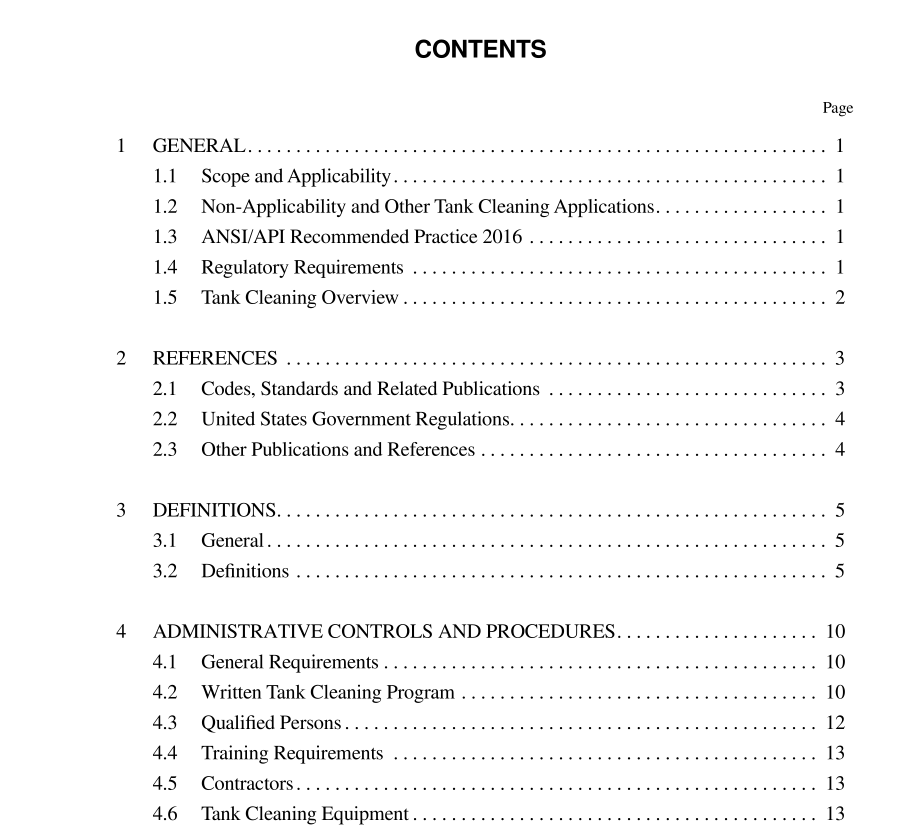API STD 2015 pdf download

API STD 2015 pdf download.Requirements for Safe Entry and Cleaning of Petroleum Storage Tanks
1 General
1.1 SCOPE AND APPLICABILITY This standard is applicable to cleaning stationary atmo- spheric and low-pressure (up to and including 15 psig) above- ground petroleum storage tanks used in all sectors of the petroleum and petrochemical industry, including crude oil and gas production, refineries, petrochemical plants, bulk plants and terminals. This standard provides requirements for safely planning, coordinating and conducting tank cleaning operations from decommissioning (removal from service) through recommissioning (return to service) tanks that have contained flammable or combustible liquids or petroleum related toxic materials. This standard does not and cannot cover every possible unique hazard or situation that may arise during tank cleaning operations. These site specific, product specific and tank specific hazards and situations must be addressed by employers (owner/operators or contractors) using the appropriate principles and considerations provided for by this standard. The ANSI/API Recommended Practice 2016, Guidelines and Procedures for Entering and Cleaning Petroleum Storage Tanks , provides supplemental information applicable to the requirements of this standard.1.4 REGULATORY REQUIREMENTS In addition to the requirements contained in this standard, employers (owners/operators and contractors) shall refer to applicable federal, state and local government regulations pertinent to specific tank cleaning activities, including regula- tions of governments other than those of the United States, when appropriate. This standard is intended to be consistent with Title 29 of the U.S. Code of Federal Regulations , Occu- pational Safety and Health Administration Standards , Part 1910, “General Industry,” and Part 1926, “Construction.” This standard is intended to be consistent with appropriate National Fire Protection Association Codes and Standards applicable to the entry and cleaning of aboveground petro- leum storage tanks. If any provision of this standard conflicts with statutory or regulatory requirements, said statutes and regulations shall govern. This standard is not intended to function as a substitute for applicable regulations, codes, standards or employer (owner/operator and contractor) safe (cold) work and hot work practices and procedures, all of which must be reviewed in their entirety to determine their applicability to the facility, its location, the tanks involved and the proposed work.1.5 TANK CLEANING OVERVIEW There are a number of basic activities applicable to every tank that is to be cleaned. These activities include, but are not limited to, confined space classification; decommissioning; product, sludge and residue removal; isolation; vapor and gas freeing, degassing and ventilation; entry; tank cleaning; atmo- spheric testing; inspection; rescue; hot and safe (cold) work operations; and recommissioning. Many of these activities are covered by existing employer programs and procedures such as Confined Space; Energy Isolation; Hot Work and Safe Work; Hazard Communications; Operations, Maintenance and Inspection; Respiratory Protection and Process Safety Hazard Analysis. ANSI/API Recommended Practice 2016, Guidelines and Procedures for Entering and Cleaning Petroleum Storage Tanks , is intended to assist employers (owners/operators and contractors) in developing plans and conducting safe tank cleaning operations in accordance with the requirements of this standard, by providing supplementary information cover- ing the following elements.
3 Definitions
3.1 GENERAL The following definitions are applicable to tank cleaning operations as described in this standard. 3.2 DEFINITIONS 3.2.1 air supplied respiratory protection: A respira- tor that provides a supply of safe breathing air from a tank (either a self contained breathing apparatus portable tank or an air line supply tank) or from a source of fresh air (approved breathing air compressor) not subject to potential contamination. 3.2.2 attendant: A qualified employee stationed outside one or more permit required confined spaces who monitors the entrants and who performs all attendant’s duties in accor- dance with the employer’s (owner/operator and contractor) permit required confined space program. Attendants may also perform the duties of standby personnel when entrants use respiratory protective equipment. 3.2.3 blanking: The absolute closure of a pipe or line by fastening a solid, flat plate (designed to retain the pressure of the pipeline), between two flanges, using two gaskets and fully engaged bolts or stud bolts in all flange bolt-holes. Blanks have handles extending beyond the flange with a 1 / 4 – inch (6.3 mm) minimum hole in the handles (see ASME B 31.3 for additional information). 3.2.4 blinding: The absolute closure of the open end of a pipe, line or pressure vessel opening by fastening a solid, flat plate (designed to retain the pressure) across the opening, using a gasket and fully engaged bolts or stud bolts in all flange bolt-holes (see ASME B 16.5 and B 16.47 for addi- tional information). 3.2.5 bonding: The joining of metal parts to form an elec- trically conductive path that ensures electrical continuity and has the capacity to safely conduct any current likely to be generated.









